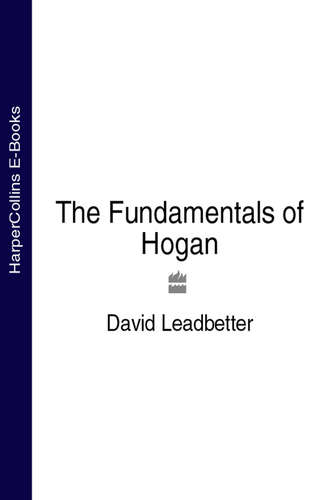
Полная версия
The Fundamentals of Hogan

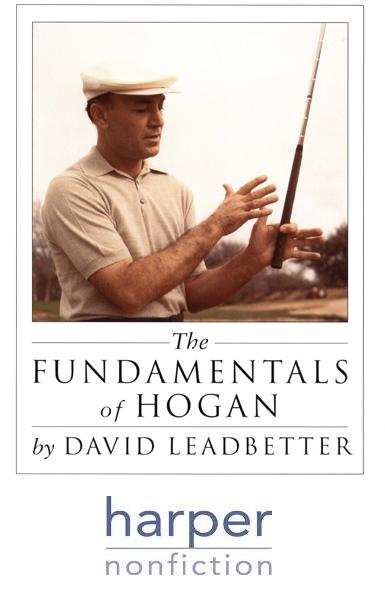
CONTENTS
COVER
TITLE PAGE
PREFACE
INTRODUCTION
THE HANDS
ADDRESSING THE BALL
THE BACKSWING
THE DOWNSWING
SUMMARY & CONCLUDING THOUGHTS
ACKNOWLEDGMENTS
KEEP READING
ABOUT THE AUTHORS
COPYRIGHT
ABOUT THE PUBLISHER
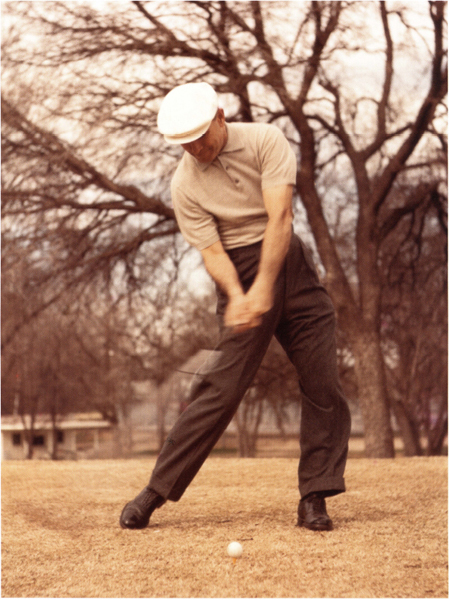
PREFACE
Like many golfers, I have always enjoyed reading instructional books. As a youngster I found myself so fascinated with reading what Arnold Palmer, Jack Nicklaus and Gary Player, the big three, as they were known, had to say about the swing that I often slipped a golf book inside the cover of a Latin textbook during school. The game of golf really intrigued me—far more than the ancient Romans did. Eventually I turned professional at the age of eighteen. I continued to read and experiment at every opportunity while I played tournaments and also while I taught the game at the club where I was working. I was curious about how one author adhered to a particular idea while another would state what seemed to be the exact opposite—yet each writer put forward a solid case for his theories. For me, golf books and learning about the swing were endlessly fascinating; I was barely through a new idea before I would go out to try it. Sometimes I even did this after work, with my car’s headlights on. By now I’ve amassed a library of instructional books, and still enjoy referring to them and studying them. My office at home is full of instructional books wherever I look, and I often find myself reaching for one, almost absent-mindedly, because, I suppose, there’s always something to learn. It might be something that six-time British Open champion Harry Vardon wrote; or an idea from the work of Bobby Jones, Byron Nelson, Ben Hogan, Sam Snead, Nicklaus, or Tom Watson. The compelling aspect of golf to me is that, as long as I’ve taught the game, I’m still learning about it.
Of all the books in my library, Hogan’s have absorbed me the most. I was always aware of his reputation as a consummate ball-striker, and so I turned to his writings with great interest. I wanted to find out what the master said, whether he was writing in magazines, in his first book Power Golf, or his classic Five Lessons: The Modern Fundamentals of Golf. I have reread Hogan’s writings many times, and have learned so much from them. I’ve analyzed his work endlessly, or so it seems to me. I continue to think about Hogan’s ideas and to learn from them. I have also adapted some of Hogan’s ideas while developing my own. I have examined from many angles what Hogan had to say.
In particular, I have had a deep and abiding interest in Five Lessons, which began as a series of lessons in the magazine Sports Illustrated. This book was the direct result of Hogan working on his own swing. Hogan was relentless in his pursuit of a correct, powerful, and repeating swing, and he eventually achieved that goal. He tested his swing in the ultimate crucible of competition at the highest levels—the major championships—and found that it stood up. Hogan won two Masters, four United States Opens, one British Open (the only one he entered), and two PGA Championships, all between 1946 and 1953. No wonder he felt he had something to contribute to the game through the written word.
After Hogan was satisfied that he’d built a swing he could depend on under pressure, he was ready to write Five Lessons. The book began as a series of five articles that Sports Illustrated published in 1957. In June 1956, the magazine had sent its golf writer Herbert Warren Wind, along with the illustrator Anthony Ravielli, to meet Hogan in his hometown of Fort Worth, Texas. Hogan at first had only one instructional article in mind on, as Wind later wrote, “the basic elements of the correct golf swing.” But Wind and Ravielli asked Hogan if he would consider a series of articles on the steps he would suggest to a golfer willing to work steadily on his swing so that he could improve. Hogan liked the idea, and the threesome worked on the project at the Colonial Country Club in Fort Worth. A second meeting took place in early January 1957, and the first of five articles was published in Sports Illustrated in its March 11, 1957 issue. The five installments in the magazine became Five Lessons, which was published later that same year.
Five Lessons: The Modern Fundamentals of Golf differed in both content and presentation from Hogan’s first book, Power Golf, published in 1948. Five Lessons has been a golfing bible for many players of all levels. Every tour player with whom I’m acquainted has read the book. Mark O’Meara, the 1998 Masters and British Open champion, first met Hogan in 1980. O’Meara had won the 1979 United States Amateur using Hogan clubs. He signed with the Hogan equipment company to play its clubs after he turned professional, at which time Hogan told him during their first meeting that he had learned the swing piece by piece, having thought about it night after night, and then trying out his ideas the next day on the practice tee. Hogan kept what worked and discarded what proved inadequate to his plan of building a reliable swing. O’Meara never forgot their conversation, and built his own swing segment by segment.
We can also think in this context of Larry Nelson, one of the most consistent players of the modern era. Nelson did not take up golf until he was twenty-one years old, having read Five Lessons closely. He used the book as a manual to help develop his technique and went on to win the 1983 U.S. Open and the 1981 and 1987 PGA Championships. Five Lessons has influenced golfers since the day it was published; the book still sells forty years after its original publication.
In my case, Five Lessons was one of the first instruction books I owned and read while growing up. The design of the book, quite apart from the elegantly expressed text, demonstrates all the organizational qualities and attention to detail that epitomized Hogan’s character. The book was certainly a classic and in my opinion was way ahead of its time. It became the benchmark for future instruction. It is also a deeply personal book in that it reflects Hogan’s attempts to deal with his own questions and provides the answers that he found. Many instruction books that professional golfers write are personal in similar ways.
I have for some years wanted to evaluate Five Lessons and some of Hogan’s other writings from the perspective of what we have learned about the golf swing since Hogan’s analyses. It seemed fortuitous, then, when I received a call in 1998 inviting me to do just that. The publisher of this book had located and secured the rights to previously unpublished photographs that Ravielli took as source material for Five Lessons. He wondered if I might be interested in examining these photographs and Hogan’s writings. I looked at the photographs and was struck by the fact that here we had Hogan posing for the pictures. He was obviously well aware of the details of his swing because he was posing in dozens of different positions. In some cases the poses represented what he did at speed and in other cases they represented what he thought he did during the swing. I was immediately reminded of a phenomenon I have so often seen in my teaching and that is applicable to all golfers: the difference between “feel and real.”
The discovery of these photographs led directly to this book. I felt a rush of excitement when the opportunity to write it presented itself, and although I had all but mapped out my entire year, I knew instantly that I wanted to begin work on this book. It was an opportunity not to be missed, To have located Ravielli’s photographs is in golfing terms an unprecedented archaeological find. I also feel fortunate to have worked with illustrator Keith Witmer on this book. Keith has a deep appreciation for the nuances of Ravielli’s work and also of Hogan’s technique.
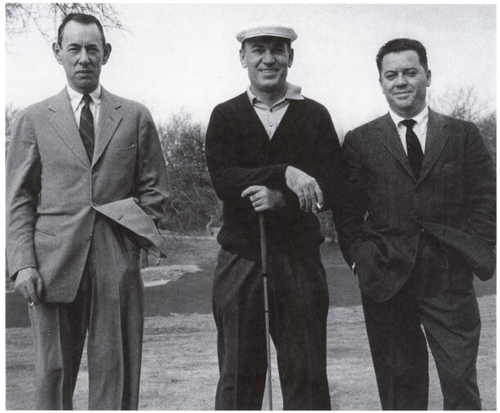
Herbert Warren Wind, Ben Hogan, and Anthony Ravielli.
It was a great stroke of luck to find Ravielli’s photographs. Any Hogan artifact is a priceless commodity, as there is not an abundance of pictures or film of him compared to the wealth of material available on today’s top players. I am thrilled to have had the opportunity to study Ravielli’s photographs and to spend so much time with Hogan’s book again. This book, The Fundamentals of Hogan, is the result of that process.

The original film Ravielli used to capture Hogan’s swing.
INTRODUCTION
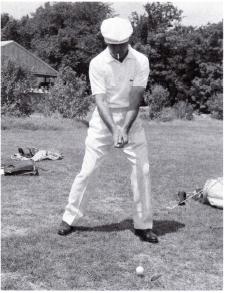
Hogan was constantly thinking about his technique.
If you were to ask today’s tour players to vote on the best ball-striker of all time, the vast majority would pick Ben Hogan. They would place him at the top of the list even though many of them never saw him hit a shot. But so mighty is the reputation of the man that his name remains synonymous with pure ball-striking. The English writer and course architect Donald Steel observed that Hogan “was an extreme perfectionist and a ruthless competitor. His control was absolute, his dedication immense. He was the finest stroke player the game has known, a legend in his lifetime.” Indeed, he is a legend beyond his lifetime; since Hogan died in 1997, his legend has only grown. Today, when a golfer controls the flight of the ball and moves it around the course at will, we say “You’re hitting it like Hogan.” There is no higher compliment. Ben Hogan remains the standard of excellence.
Hogan’s reputation as the game’s preeminent ball-striker could well last as long as the game is played. At the same time he could be called the father of modern golf instruction—in which the basic idea is that the player is to use the big muscles of the body, rather than the hands, as the controlling influences in the swing. Nobody has influenced modern-day teaching more than Hogan. His years of observation, his unceasing trial-and-error experimentation that he put to the test in championships, his love for hitting practice balls, and his unwavering desire for perfection, led him to become the most precise golfer in the annals of the game. Hogan was the consummate practicer and tinkerer, and enjoyed working on his technique at every opportunity. He would use any location in his pursuit of swing perfection: driving ranges and fields en route to a tournament, hotel rooms, locker rooms—any place where he could swing a club.

The locker room practice session!
Hogan is truly a legend—one of the game’s most esteemed players. Yet many observers did not consider Hogan to be a natural player in the same vein, for instance, as his archrival Sam Snead. He worked extremely hard to achieve his results precisely because he wasn’t a natural player, making several dramatic changes to his swing over the years. Hogan’s own efforts and results proved to him that it was indeed possible to improve by working on fundamentals. In Hogan’s case, his hard work culminated in his finding, by 1946, his so-called “secret,” a formula to eliminate the persistent hooking problem that early on threatened to ruin his development as a tournament player. This gave him complete mastery over the golf ball and allowed him to play the commanding golf for which he became famous. It was during the next seven years that he won his nine major championships.
Hogan’s ability to change his swing was impressive. Every golfer who has tried to modify his swing knows how formidable a task it can be; one’s instincts and habits always seem ready to show up again under pressure no matter how hard one works. Every golfer is different and every swing has its own look, which is why one can readily identify a player from a distance as he swings.
Hogan, too, had his personal look, and during his ruthless self-examination he learned that he was prone to a loss of control for specific reasons. His great flexibility caused him to swing the club back a long way and gave the impression that he had a fairly wristy swing, which, when combined with his fiery leg action, led to his early tendency to lose control of the clubface through impact and to hook the ball. But finally one could candidly state that for a period of time Hogan mastered the game and overcame his few bad tendencies—by finding and incorporating the small number of fundamentals which allowed him to develop a repeating, effective swing. This mastery enabled him to manage his game so that he could plot his way around a course like a chess player; no fairway was too narrow and no pin was inaccessible. His course management and attention to detail were second to none, and his scores showed it. One might point to his play while winning the Masters, United States Open, and British Open in 1953 as proof of the soundness of his swing theories; he dismantled an extremely difficult Carnoustie in Scotland that year while winning the British Open with descending scores of 73-71-70-68. Hogan learned a little more every day about how to play the course. He had the tools—the refined, simplified technique—to dissect the challenging links. The Daily Telegraph newspaper asked after his victory: “And who shall say he’s not the best of all time?”
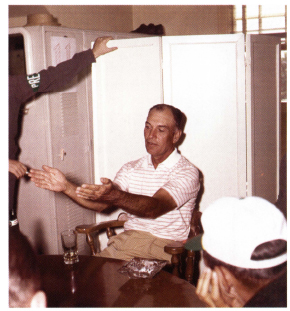
When Hogan spoke, everyone listened.
As serious a student of the game as Hogan was, he did not have the luxury of using highspeed sophisticated video cameras or computers to analyze other swings or his own. He remarked in his later years that had he had such equipment he would have understood the swing ten years sooner. He also did not shave a full-time coach as most players do today, although Hogan did on occasion confer with the renowned professional Henry Picard. But his uncanny sensory system, his powers of observation, and his tremendous kinesthetic awareness of how his body and the golf club functioned during the motion of a swing provided the underpinnings of his education. His greatest success occurred when he developed total belief in his technique so that he could play without worrying about bad shots. His relentless pursuit and eventual achievement of building a correct, powerful, and repeating swing that he could depend on under pressure led him to write Five Lessons. Hogan’s book was published four years after he won those three majors in 1953. It is, as I have noted, a deeply personal book. It is a book about Hogan’s search for a better swing for himself, and in it—having written Power Golf and in a variety of other publications—he offers his conclusions about what all golfers can learn from his own quest. His teachings have so much to offer golfers, but it has always been important that readers interpret his ideas correctly and clarify them properly. I hope to help with this.
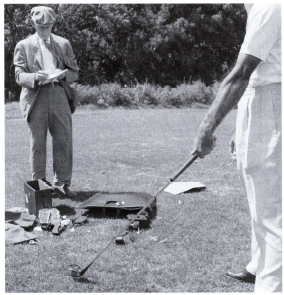
Working with Herbert Warren Wind on Five Lessons.
Hogan was a superior athlete, gifted with remarkable flexibility and range of motion, as well as an imaginative mind. According to many people, his intellect bordered on genius. Gardner Dickinson, a professional golfer who won three tournaments on the U.S. tour from 1968-1970 and played on two Ryder Cup teams, worked as an assistant to Hogan when he was briefly the head professional at the Tamarisk Country Club in Palm Springs, California during the early 1950s. Dickinson held a degree in clinical psychology and was qualified to administer psychological tests. He could not prevail upon Hogan to take a standard intelligence test, but did slip in some questions during their conversations. He estimated that Hogan’s I.Q. was in the high genius category.
Combine Hogan’s inherent qualities with his intense concentration and steely focus, and it is apparent he always had the foundation to become one of the game’s finest players. Hogan had the strength, speed, and agility that are ideal for taking up the demands of golf. He had fairly long arms relative to his height (he stood 5 feet 8V½ inches), with a powerful, compact body; at the height of his career he weighed in the region of 140 pounds, and every pound seemed there for one purpose—to strike the golf ball efficiently. He also had big hands and very strong forearms, which helped him hold on to the club with control and power from start to finish. I also believe that his powerful lower body, in particular the strong gluteus maximus muscles (buttocks) and thighs aided his superb stability—a major factor in enabling him to go at the ball hard while retaining perfect balance.
Having been fortunate enough to be involved in the teaching side of golf for years and having taught some of the world’s great modern players, I regard the writing of this book as a labor of love and joy. It is an honor for me, but moreover it is a tribute to a man that I, along with millions of others, have long admired and respected. Many younger golfers have heard of Hogan but perhaps do not realize he was the ultimate technician of the swing, and that he had more control of the ball than anyone who has played the game. Many good players like to draw the golf ball, but some of the greats prefer to fade it; that was true of Hogan, and it is also true of Jack Nicklaus. In Hogan’s day, players had such immense respect for him that they would stop their own practice sessions and gather to watch the master at work. Though Hogan was basically a quiet man, even taciturn, when he talked about the golf swing players listened intently. Tommy Bolt once said that he remembers Jack Nicklaus watching Hogan practice, but that he never saw Hogan watching Nicklaus. Bolt meant this not as a slight to Nicklaus, but as a statement about Hogan’s reputation and exalted place in the game.
My goals in this book are threefold: (1) to examine what Hogan believed about the swing; (2) to offer my interpretations and, in some cases, examine his thinking as expressed primarily in Five Lessons, but also from other sources, so that I might provide a complete picture. Hogan wrote the aforementioned Power Golf, and also in such publications as Life and Esquire, and of course he wrote for and was often quoted in golf magazines. In regard to his many writings I will attempt to clear up some misconceptions that have arisen over the years. Speaking from experience, I am aware that misconceptions can easily arise when dealing with the complexities of the golf swing; and (3) to offer advice that could help golfers of all ability levels who dream of shooting 80 or lower; not so that golfers can recreate Hogan’s swing—that would be impossible—but so that they can learn from him and incorporate certain elements into their games and so become more consistent. Hogan believed that the golfer who studied and understood the basics of the swing and who then applied these principles in practice could develop a consistent swing and break 80. I also believe this.
On the subject of breaking 80, I think it is important to realize that this is indeed a dream for many golfers—a dream they hope to turn into reality. An improved golf swing will go a long way toward achieving this goal. At the same time, we should never forget how important it is to work on your short game and develop it in tandem with your long game. Hogan did not address the short game in Five Lessons nor will I do so here. But an improved short game is vital to any golfer’s plan to reach his potential. Ideally this book will help you improve your swing so that you do not have to tinker with it every time you practice. You will, I hope, be able to use your practice sessions to maintain your newfound, reliable swing and to devote more time to your short game. When I visit golf courses I see people beating golf balls hour after hour in hopes of improving their swings, although frequently they are working without a plan or concept—and they rarely work on their short games. This is understandable because they hit the ball poorly and are motivated to find something, anything, on the range.
I hope to give you that “something” in these pages, and in doing so free you to spend more time on your short game. This should help you become a consistent 80-breaker; or if you are already at that stage, a par-breaker.
I might add that I think along lines similar to Hogan in many important ways and consider myself something of a traditionalist when it comes to teaching the swing. I have always believed that no golfer can make headway in the game without understanding the fundamentals; the idea is then to stick with and work at these fundamentals. If in tandem you can develop a good short game, then you may well turn that dream of breaking 80 or breaking par into reality. This is one reason I am excited by the prospect of helping to bring Hogan again to the forefront of golfers’ minds, and ensure that he remains there. I consider this book a conversation with Hogan about his theory of the swing, and a blending of what we have learned about it and what we can hope to achieve in further study. It’s a blending, in other words, of the past and present with an eye to the future.
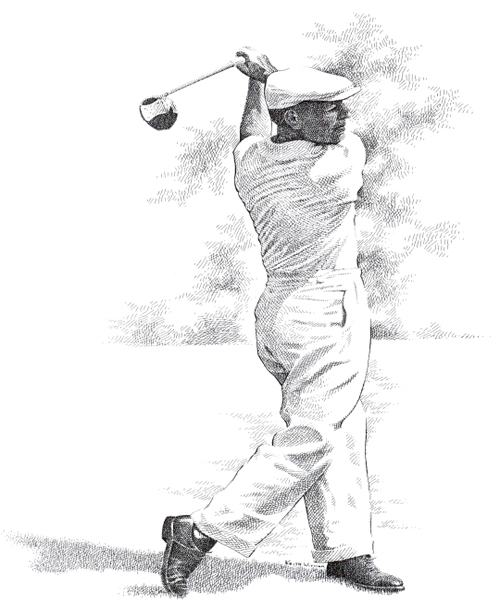
Stability and balance were major factors in Hogan’s swing.
As much as this book is an opportunity for me to engage with Hogan’s thinking, I am at the same time reminded that I never saw the man strike a ball. This is my one big regret in golf. On one occasion my friend and student David Frost, who was on good terms with Hogan and represented the Hogan company, set up a time for me to watch him hit balls at Shady Oaks, his club in Fort Worth. Regrettably, Hogan became ill and my visit was canceled. Still, in the course of writing this book I do feel that in a way I encountered Hogan. My research led me to speak with many people who knew him and his game, and to examine every bit of information available about Hogan, including books, films, and letters. I feel I have come to know him—not only his swing but to some extent what made him tick—and I can only say I have more admiration for the man now than ever before.
It is interesting to note that while Hogan said years after writing the book that he put everything he knew about the swing into it, still he felt that there was more to learn. Hogan, in fact, encouraged further study and interpretation by declaring in Five Lessons: “I hope that these lessons will serve as a body of knowledge that will lead to further advances in our understanding of the golf swing. Every year we learn a little more about golf. Each new chunk of valid knowledge paves the way to greater knowledge. Golf is like medicine and the other fields of science in this respect.” Nick Price, with whom I have had the good fortune to work for years, feels that he could compress twenty-five years of learning into just a couple with the information available today. The pace of learning is accelerated and compressed today; all golfers including those who have played for decades can benefit from the advances in teaching.




